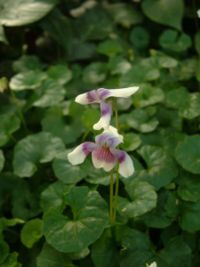| subsp. var.
|
|

|
| Habit:
|
|
[[Category:]]
|
| Height:
|
⇕
|
to
|
| Width:
|
⇔
|
to
|
|
|
cm
|
|
| Height:
|
⇕
|
cm to The wikipage input value is empty (e.g. <code>SomeProperty::, [[]]</code>) and therefore it cannot be used as a name or as part of a query condition.
|
| Width:
|
⇔
|
The wikipage input value is empty (e.g. <code>SomeProperty::, [[]]</code>) and therefore it cannot be used as a name or as part of a query condition. to The wikipage input value is empty (e.g. <code>SomeProperty::, [[]]</code>) and therefore it cannot be used as a name or as part of a query condition.
|
| Lifespan:
|
⌛
|
|
| Origin:
|
✈
|
|
| Poisonous:
|
☠
|
|
| Bloom:
|
❀
|
|
|
| Exposure:
|
☼
|
|
| Water:
|
◍
|
|
| Features:
|
✓
|
|
| Hidden fields, interally pass variables to right place
|
|
|
| Minimum Temp:
|
☃
|
°F
|
| USDA Zones:
|
|
to
|
| Sunset Zones:
|
|
|
| Flower features:
|
❀
|
|
|
|
|
| Standard Cyclopedia of Horticulture
|
|
Viola hederacea, Labill. (Erpetion reniforme, Sweet. E. hederaceum, E. petiolare, and E. spathulatum, Don). Australian Violet. Tufted, and creeping by stolons, glabrous or pubescent: lvs. reniform or orbicular or spatulate, small, entire or toothed, usually not equaling the scapes: fls. small, usually blue, sometimes white, the spur almost none. Austral. G. 35:35.—Offered in S.Calif.
The above text is from the Standard Cyclopedia of Horticulture. It may be out of date, but still contains valuable and interesting information which can be incorporated into the remainder of the article. Click on "Collapse" in the header to hide this text.
|
| Viola hederacea {{{status}}} Fossil range: {{{fossil_range}}}
|

|
| Plant Info
|
| Common name(s):
|
|
{{{common_names}}}
|
| Growth habit:
|
|
{{{growth_habit}}}
|
| Height:
|
⇕
|
{{{high}}}
|
| Width:
|
⇔
|
{{{wide}}}
|
| Lifespan:
|
⌛
|
{{{lifespan}}}
|
| Exposure:
|
☼
|
{{{exposure}}}
|
| Water:
|
☂
|
{{{water}}}
|
| Features:
|
❀
|
{{{features}}}
|
| Poisonous:
|
☠
|
{{{poisonous}}}
|
| Hardiness:
|
❆
|
{{{hardiness}}}
|
| USDA Zones:
|
|
{{{usda_zones}}}
|
| Sunset Zones:
|
|
{{{sunset_zones}}}
|
|
| Scientific classification
|
| Domain:
|
{{{domain}}}
|
| Superkingdom:
|
{{{superregnum}}}
|
| Kingdom:
|
Plantae
|
| Subkingdom:
|
{{{subregnum}}}
|
| Superdivision:
|
{{{superdivisio}}}
|
| Superphylum:
|
{{{superphylum}}}
|
| Division:
|
Magnoliophyta
|
| Phylum:
|
{{{phylum}}}
|
| Subdivision:
|
{{{subdivisio}}}
|
| Subphylum:
|
{{{subphylum}}}
|
| Infraphylum:
|
{{{infraphylum}}}
|
| Microphylum:
|
{{{microphylum}}}
|
| Nanophylum:
|
{{{nanophylum}}}
|
| Superclass:
|
{{{superclassis}}}
|
| Class:
|
Magnoliopsida
|
| Sublass:
|
{{{subclassis}}}
|
| Infraclass:
|
{{{infraclassis}}}
|
| Superorder:
|
{{{superordo}}}
|
| Order:
|
Malpighiales
|
| Suborder:
|
{{{subordo}}}
|
| Infraorder:
|
{{{infraordo}}}
|
| Superfamily:
|
{{{superfamilia}}}
|
| Family:
|
Violaceae
|
| Subfamily:
|
{{{subfamilia}}}
|
| Supertribe:
|
{{{supertribus}}}
|
| Tribe:
|
{{{tribus}}}
|
| Subtribe:
|
{{{subtribus}}}
|
| Genus:
|
Viola
|
| Subgenus:
|
{{{subgenus}}}
|
| Section:
|
{{{sectio}}}
|
| Series:
|
{{{series}}}
|
| Species:
|
V. hederacea
|
| Subspecies:
|
{{{subspecies}}}
|
|
| [[{{{diversity_link}}}|Diversity]]
|
| {{{diversity}}}
|
| Binomial name
|
Viola hederacea
|
| Trinomial name
|
{{{trinomial}}}
|
| Type Species
|
{{{type_species}}}
|
| {{{subdivision_ranks}}}
|
|
|
[[Image:{{{range_map}}}|{{{range_map_width}}}|]]
|
| Synonyms
|
| {{{synonyms}}}
|
Viola hederacea, also known as the Australian violet is a species of violet which is native to Australia. It is common and widespread in Victoria and Tasmania, along the Great Dividing Range in New South Wales north at least to the Barrington Tops area, in the far south-east of South Australia, and in a small area of the Adelaide Hills between Belair and Mount Lofty.
The flowers are usually rather pale and washed-out looking, the anterior petal (the one at the bottom of the flower when looking face on) is widest towards its apex, and the mature seeds are brown. Well-developed leaves of Viola hederacea are also distinctive – semicircular in outline, about as broad as long, and usually rather dark green above and paler beneath.
True Viola hederacea is infrequently grown in gardens. It is a less spectacular plant than the cultivated species (Viola banksii), with a more open, less robust habit and less striking flowers. Nevertheless, it’s easy to cultivate.
References
- Thiele, K & Prober, S (2003). "New species and New Hybrid in the Viola hederacea species complex, with notes on Viola hederacea Labill.". Muelleria 18: 7–26.

